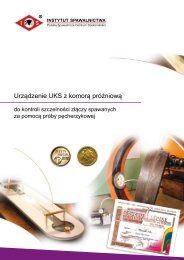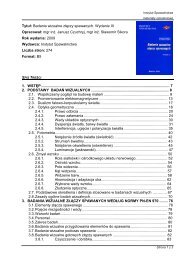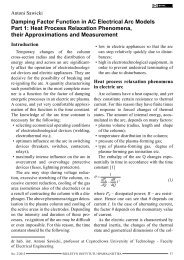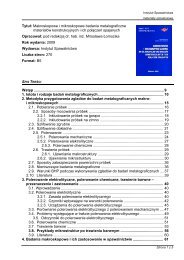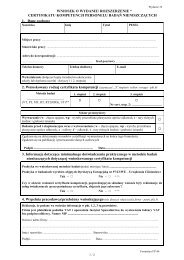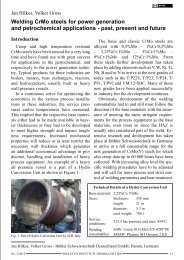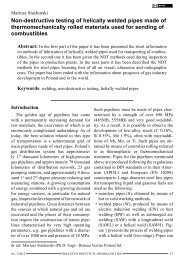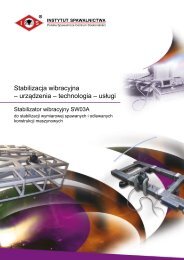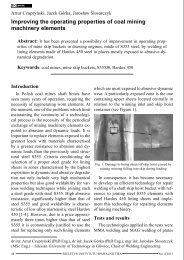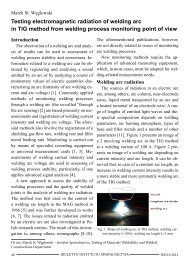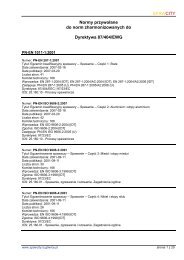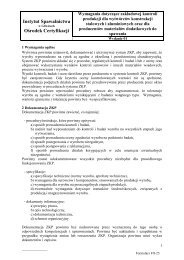Biuletyn Instytutu Spawalnictwa No. 01/2012
Biuletyn Instytutu Spawalnictwa No. 01/2012
Biuletyn Instytutu Spawalnictwa No. 01/2012
Create successful ePaper yourself
Turn your PDF publications into a flip-book with our unique Google optimized e-Paper software.
pulses up to several dozen milliseconds<br />
long, enabling simultaneous,<br />
almost steady, shaping of the course<br />
of power within the duration of<br />
a pulse i.e. shaping the division of<br />
pulse duration into time sub-areas<br />
(sectors) with very big density.<br />
The complex shape of a pulse is<br />
the result of the division of the basic<br />
(rectangular) pulse into sectors of specific<br />
height and width. The length of each sector can<br />
be contained within the range of 0.3ms÷50ms<br />
with an increment of 0.1ms in the case of many<br />
precise laser welding machines. The height of<br />
rectangular pulse, P i max<br />
=2250 W<br />
penetration depth h=1.52 mm<br />
face width s=1.36 mm<br />
shaped pulse, P i max<br />
=5556 W<br />
penetration depth h=1.76 mm<br />
face width s=1.67 mm<br />
shaped pulse, P i max<br />
=5556 W<br />
penetration depth h=1.91 mm<br />
face width s=1.49 mm<br />
Fig. 6. Geometry of penetrations of steel X15CrNiSi20-12 made with laser<br />
beam emitted in pulsed mode with various pulse shapes;<br />
diameter of focusing area 0.8 mm, emission frequency 5 Hz,<br />
pulse energy 18 J, pulse duration 8 ms, welding rate 1.6 mm/s [2]<br />
Fig. 5. Typical shapes of laser radiation beam pulse<br />
each sector can adopt values from the range<br />
0%÷100% of the specific power of a pulse.<br />
The shape of a pulse should be optimised in<br />
relation to the basic physicochemical properties<br />
of the material being welded, in particular<br />
to the absorptivity of surfaces being processed.<br />
The most commonly applied shapes<br />
are simple rectangular pulses (Fig.<br />
5a), rectangular pulses with a very<br />
short phase of high power and a long<br />
phase of low power (Fig. 5b) (applied<br />
while welding materials which strongly<br />
reflect radiation), and pulses with<br />
the gentle edge of radiation beam power<br />
decrease (Fig. 5c) (applied when<br />
the limitation of the dynamics of a<br />
welding thermal cycle is required e.g.<br />
in the case of materials susceptible to<br />
hot cracking).<br />
Appropriate shaping of a pulse<br />
through the composition of several<br />
phases adopting the form of a rectangular<br />
pulse and a pulse of edges<br />
of rising and falling power of a radiation<br />
beam can make it possible to<br />
produce proper joints without imperfections<br />
occurring in typical welding<br />
conditions.<br />
In the majority of typical cases it is<br />
the application of a rectangular pulse<br />
that makes it possible to obtain desirable<br />
results. As regards testing the<br />
impact of the parameters of YAG pul-<br />
NR <strong>01</strong>/2<strong>01</strong>2<br />
BIULETYN INSTYTUTU SPAWALNICTWA<br />
9



